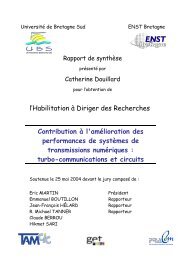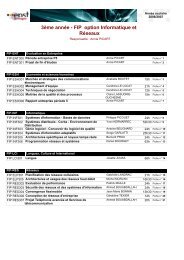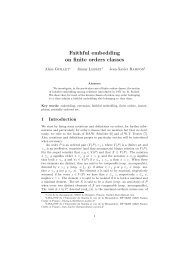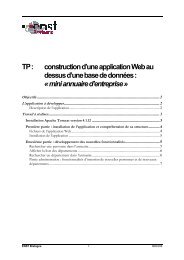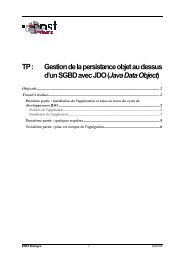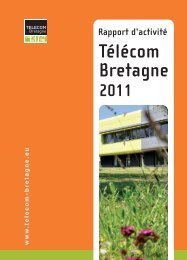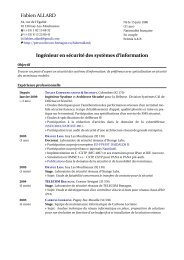Weakly supervised classification of objects in images using soft ...
Weakly supervised classification of objects in images using soft ...
Weakly supervised classification of objects in images using soft ...
You also want an ePaper? Increase the reach of your titles
YUMPU automatically turns print PDFs into web optimized ePapers that Google loves.
4 Riwal Lefort, Ronan Fablet, Jean-Marc BoucherConsequently, given a constructed decision tree, a test sample will be passedtrough the tree and be assigned the class priors <strong>of</strong> the term<strong>in</strong>al it will reache.Let us denote by p mi the class priors at node m <strong>of</strong> the tree. The key aspect<strong>of</strong> the weakly <strong>supervised</strong> learn<strong>in</strong>g <strong>of</strong> the s<strong>of</strong>t decision tree is the computation <strong>of</strong>class prior p mi at any node m. In the <strong>supervised</strong> case it consists <strong>in</strong> evaluat<strong>in</strong>g theproportion <strong>of</strong> each class at node m. In a weakly <strong>supervised</strong> learn<strong>in</strong>g context, realclasses are unknown and class proportions can not be easily assessed. We proposeto compute p mi as a weighted sum over priors {π ni } for all samples attached tonode m. For descriptor d, denot<strong>in</strong>g x d n the <strong>in</strong>stance value and consider<strong>in</strong>g thechildren node m 1 that groups together data such as {x d n} < S d , the follow<strong>in</strong>gfusion rule is then proposed: ∑pm1i ∝(π ni ) α (3){n}|{x d n } S d , the∑(π ni ) α (4){n}|{x d n }>S dThe considered power α weighs low-uncerta<strong>in</strong>ty samples, i.e. samples such thatclass priors closer to 1 should contribute more to the overall cluster mean p mi . An<strong>in</strong>f<strong>in</strong>ite exponent values resorts to assign<strong>in</strong>g the class with the greatest prior overall samples <strong>in</strong> the cluster. In contrast, an exponent value close to zero withdrawsfrom the weighted sum low class prior. In practice, we typically set α to 0.8.This sett<strong>in</strong>g comes to give more importance to priors close to one. If α < 1, highclass priors are given a similar greater weight compared to low class priors. Ifα > 1, the closer to one the prior the greater the weight.Consider<strong>in</strong>g a random forest, the output from each tree t for a given testdata x is a prior vector p t = {p ti }. p ti is the prior for class i at the term<strong>in</strong>alnode reached for tree t. The overall probability that x is assigned to class i, i.e.posterior likelihood p(y = i|x), is then given by the mean:p(y = i|x) = 1 T∑p ti (5)Tt=1where y n = i denotes that sample x n is assigned to class i. A hard <strong>classification</strong>resorts to select<strong>in</strong>g the most likely class accord<strong>in</strong>g to posteriors (5).3 Iterative <strong>classification</strong>In this section, an iterative procedure that is applied to the tra<strong>in</strong><strong>in</strong>g dataset issuggested. A naive version is first presented, and f<strong>in</strong>ally, a more robust versionthat avoids over tra<strong>in</strong><strong>in</strong>g is proposed.3.1 Naive iterative procedureThe basic idea <strong>of</strong> the iterative scheme is that the class priors <strong>of</strong> the tra<strong>in</strong><strong>in</strong>gsamples can be ref<strong>in</strong>ed iteratively from the overall knowledge acquired by the



